E-Archive
Cover Page
in Vol. 21 - May Issue - Year 2020
Individual Blasting Tasks Require Individual Blasting Technology Solutions
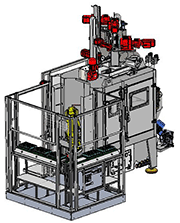
1st step: sketch of the machine
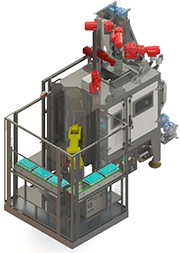
2nd step: 3D-layout
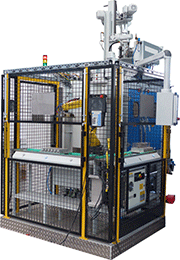
3rd step: real machine
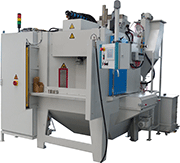
Fully automated wet blasting machine for deburring of stainless-steel parts
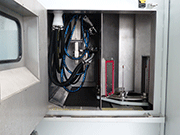
Wet blasting chamber and integrated cleaning chamber
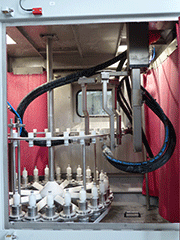
Inside view of a fully automated wet blasting “batch” machine for edge rounding of cutting tools
Wet blasting is one of the key technologies for various special applications!
Sandblasting systems are part of the basic equipment in almost every area of surface technology. The variety of the most different, available blasting methods always puts the user before the question of an optimal solution for their individual application.
It is therefore particularly important to take a close look at the respective task in advance in order to identify the optimal method and to commit to the appropriate procedure.
Often obsolete and / or environmentally harmful processes are replaced by the blasting technology, as an example here would be the manual or chemical deburring, brushing or various grinding processes and many others. In many areas, blasting technology can simplify existing processes and make production processes more economical. So, there is always the question of whether blasting can be or is a sensible alternative to other processes.
However, only specialists with many years of experience and extensive knowledge in the field of blasting technology can answer the essential question of what the right system is, since the specific requirements for each application are completely different and, in almost all cases, no generally applicable literature is available.
Wet blasting is a process that has been continuously developed over the past few years by Paul AUER GmbH. The initially very-simple systems, mainly manual hand-blasting cabins with a simple container in which blasting agent is mixed with water and kept in a mixture by means of special mixers, are still in use in many companies, but the demand for more complex and fully automatic systems has been steadily increasing over recent years. This is mainly due to the high and ever-increasing demands on the reproducibility of the blasting results, also due to increasing quantities, but also due to the differences to and the advantages compared to dry blasting.
The principle of operation:
This is iIn contrast to dry blasting, in which, as the name suggests, the blasting agent and the workpieces must be as dry as possible and also have to remain, since moisture or greasy or oily impurities will lead to clumping of the blasting agent and thus to a malfunction. In the wet blasting process, a certain amount of blasting agent is specifically mixed with water. This mixture of water and abrasive is then transported to a blasting nozzle pre-accelerated, where it is normally additionally pressurized with compressed air. The resulting spray jet is then directed onto the surface to be processed and the blasting agent contained in the water in interaction generates a corresponding surface. Classic blasting media for wet blasting are corundum, ie aluminum oxides in the qualities "brown", white "or" pink ". Glass beads or ceramic beads or various plastic granules are also used very frequently here. The use of other special abrasives is possible in principle, but requires previous tests. A selection of the suitable blasting agent and the corresponding grit is therefore made, as with most blasting tasks, on the basis of the requirements for the blasting result and is determined in many cases using previous, sometimes extensive blasting tests.
Since wet blasting offers a wide variety of advantages over dry blasting, it not only replaces other processes in a wide variety of areas, but increasingly also dry blasting itself. So especially where dry blasting is not suitable or cannot achieve the desired blasting result, the wet blasting method is preferred.
The main advantages of wet blasting are:
That moist, or wet and slightly oily workpieces can be processed without any problems
That no additional extraction in the form of dedusting (dust extraction) is required, since the abrasion that occurs during wet blasting is immediately bound in the water and thus the generation of dust is almost completely avoided, exactly the opposite of the process of dry blasting
The use of the finest grains of the respective abrasive is particularly easy, again here completely contrary to dry blasting, and poses no problem at all for a wet blasting process
The abrasive consumption is significantly lower than in comparison to dry blasting, the impact of the individual abrasive grains is dampened by the surrounding water
The homogeneity of the blasting agent-water mixture creates an equally homogeneous, that is, uniform and constant surface quality, which is crucial in many areas for the selection of wet blasting
By precisely regulating the quantity and pressure of the blasting agent-water mixture that is conveyed to the blasting nozzle and additionally regulating the compressed air supply, the blasting result can be adjusted with a correspondingly fine blasting agent even in the µm range.
By adding corrosion protection or other additives to the water-blasting agent mixture, the properties of the surface can be adapted to individual needs and subsequent manufacturing steps and thus improved
The risk of blasting media damage impacting the surface with dry blasting, especially with softer metals, is significantly reduced by using wet blasting processes
Depending on the abrasive used and the grain size, it is possible to produce much smoother surfaces than with dry blasting
A special requirement and at the same time challenge with wet blasting is the preparation of the blasting agent / water mixture. As opposed to dry blasting systems, in which grain that is too fine can simply be vacuumed off and grain that is too coarse or impurities can be sieved out, everything remains in the water bath during wet blasting. Since enrichment cannot be prevented, the entire blasting agent-water mixture must be completely replaced after a certain time (service life) in many systems and replaced with new ones. The change interval must therefore always be completely adapted to the respective application and can therefore be required monthly or significantly more often. Decisive for this change are regular checks of the mixture and an equally regular check of the blasting results.
The complete automation of a wet blasting system does not only concern the transport of the workpieces through the system, or any movements, such as the blast nozzle movement, or other processes within the blasting chamber, but the considerations must also always include the treatment of the respective blasting agent / water mixture and its composition in order to be able to guarantee constant and optimal blasting results.
The abrasive and water treatment as a basic, additional topic therefore concerns in particular:
The removal of introduced impurities, such as emitted particles, oils, fats, or other impurities
A constant or as constant-as-possible concentration of the blasting water mixture
The separation of water and blasting media for the generation of clarified water, for possibly integrated rinsing processes
The return of the separated blasting media to the blasting area in order not to change the mixing ratio
An additional, as constant or as constant-as-possible grain fraction (average size of the abrasive grains)
Where possible, a separation of good and bad abrasive grains and their internal transmission
A fully automatic concentration measurement with associated, fully automatic blasting media replenishment
etc.
Classic tasks for a wet blasting process:
The processing of special materials or alloys where sparking or heating must be prevented, e.g. in aerospace
The controlled and very precise removal of layers without changing the substrate materials and at the same time ensuring the requirements for pretreatment for further processes, such as for turbines for energy generation and their individual parts
Pretreatment of various materials before coating e.g. PVD
Rounding of cutting edges of tools, such as indexable inserts, drills, milling cutters etc. with µm accuracy, in order to significantly increase the service life of such tools.
Precise deburring of (cutting) edges without changing the actual geometry
Cleaning dies and molds
General removal of deposits, deposits, or layers
Processing of surfaces from food and medical technology, often made of stainless steel or other special materials, in order to achieve additional smoothing and thus minimize the adherence and penetration of bacteria and viruses.
Classic restoration of historical goods to reveal the original surface
General overhaul work in mechanical engineering and the automotive industry
The basic procedure for wet blasting:
In a fully automatic system, the workpiece is placed in the workpiece carrier, this can be done manually by hand, or also by a robot or corresponding handling systems, which can be offered to the respective workpiece in consultation with the customer. The individual carriers are designed so that they automatically pass through the blasting process optimally and ensure a perfect blasting result. The individual blasting process then runs according to the parameters of the individual blasting program stored in the PLC control.
If necessary, rinse water can be generated during the entire process, with which the respective workpiece can then be rinsed in a separate rinsing chamber of the blasting machine and thus pre-cleaned for subsequent processes. An additional blow-off process can take place in another chamber, which dries the component and thus further improves component cleanliness. The workpiece can then be removed. All automatic processes are largely parallel and time-optimized.
Paul AUER GmbH masters the art of the interplay of all these complex parameters of such an automatic blasting system. Starting with the selection of the right blasting agent, its use in the blasting system and an optimal preparation is performed in order to keep operating and other costs under control.
For Information:
Paul AUER GmbH
Technology for Surface Treatment
Bad Kreuznacher Straße 18
D-68309 Mannheim, Germany
Tel. +49.621.727 69 -15
Fax +49.621.727 69 -88
E-mail: b.laskowski@auer-strahltechnik.de
www.auer-strahltechnik.de



























